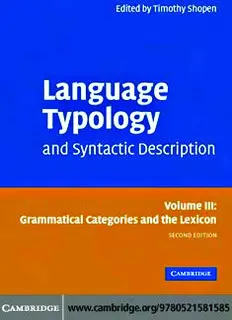Table Of ContentThis page intentionally left blank
LanguageTypologyandSyntacticDescription
Secondedition
VolumeIII:GrammaticalCategoriesandtheLexicon
Thisuniquethree-volumesurveybringstogetherateamofleadingscholarsto
explorethesyntacticandmorphologicalstructuresoftheworld’slanguages.
Clearlyorganizedandbroad-ranging,itcoverstopicssuchaspartsofspeech,
passives, complementation, relative clauses, adverbial clauses, inflectional
morphology, tense, aspect mood, and deixis. The contributors look at the
majorwaysthatthesenotionsarerealized,andprovideinformativesketches
ofthematworkinarangeoflanguages.Eachvolumeisaccessiblywritten
andclearlyexplainseachnewconceptintroduced.Althoughthevolumescan
bereadindependently,togethertheyprovideanindispensablereferencework
for all linguists and field workers interested in cross-linguistic generaliza-
tions.Mostofthechaptersinthesecondeditionaresubstantiallyrevisedor
completelynew–someontopicsnotcoveredbythefirstedition.Volumeiii
coverstypologicaldistinctionsinwordformation;lexicaltypologies;inflec-
tionalmorphology;genderandnounclasses;aspect,tense,mood;andlexical
nominalization.
Timothy Shopen (1936–2005) was Senior Lecturer in Linguistics at the
AustralianNationalUniversity.Hehadoverfortyyears’experienceofteach-
ingandresearchingavarietyoftheworld’slanguages,andalsoheldposts
at Indiana University and the Center for Applied Linguistics in Arlington,
Virginia.InadditiontoLanguageTypology,hewaseditorofStandardsand
DialectsinEnglish(1980),StandardsandVariablesinEnglish(1981),Lan-
guagesandtheirSpeakers(1987),andLanguagesandtheirStatus(1987).
Language Typology and
Syntactic Description
Second edition
Volume III: Grammatical Categories
and the Lexicon
Editedby
TimothyShopen†
CAMBRIDGEUNIVERSITYPRESS
Cambridge, New York, Melbourne, Madrid, Cape Town, Singapore, São Paulo
Cambridge University Press
The Edinburgh Building, Cambridge CB28RU, UK
Published in the United States of America by Cambridge University Press, New York
www.cambridge.org
Information on this title: www.cambridge.org/9780521581585
© Cambridge University Press 2007
This publication is in copyright. Subject to statutory exception and to the provision of
relevant collective licensing agreements, no reproduction of any part may take place
without the written permission of Cambridge University Press.
First published in print format 2006
ISBN-13 978-0-511-35495-3 eBook (EBL)
ISBN-10 0-511-35495-9 eBook (EBL)
ISBN-13 978-0-521-58158-5 hardback
ISBN-10 0-521-58158-3 hardback
ISBN-13 978-0-521-58855-3 paperback
ISBN-10 0-521-58855-3 paperback
Cambridge University Press has no responsibility for the persistence or accuracy of urls
for external or third-party internet websites referred to in this publication, and does not
guarantee that any content on such websites is, or will remain, accurate or appropriate.
Contents
Listoffigures page xi
Listoftables xii
Listofcontributors xiv
Acknowledgements xv
Listofabbreviationsandsymbols xvii
1 Typologicaldistinctionsinword-formation 1
Alexandra Y. Aikhenvald
0 Introduction 1
1 Theword 1
2 Morphologicaltypologyandword-formation 3
2.1 Transparencyofword-internalboundaries 3
2.2 Internalcomplexityofgrammaticalwords 5
2.3 Integratingthetwoparameters 8
2.4 Word-formationandsyntaxinlanguagesofdifferenttypes 9
3 Nounincorporation 11
3.1 Formalpropertiesofincorporation 12
3.1.1 Whatmaterialgetsincorporated 12
3.1.1.1 (i)Incorporationofafreeformofanoun 12
3.1.1.2 (ii)Incorporationofabarenounroot 12
3.1.1.3 (iii)Incorporationofasuppletiveorreduced
stem 13
3.1.1.4 (iv)Incorporationofthewholenp 13
3.1.2 Thedegreeofformalcohesionbetweencomponents 14
3.2 Functionaltypesofincorporation 15
3.2.1 Type1.Lexicalcompounding 15
3.2.2 Type2.Themanipulationofcase 16
3.2.3 Type3.Theregulationofinformationflow 17
3.2.4 Type4.Incorporationofmodifiers 17
3.2.5 Type5.Classificatoryincorporation 17
3.3 Syntacticfunctionsofincorporatednouns,andtheir
incorporability 19
4 Structureandiconicityinword-formation 21
5 Compounding 24
5.1 Howtodistinguishcompoundsfromphrases 24
5.1.1 (i)Phonologicalcriteria 25
5.1.2 (ii)Morphologicalcriteria 26
v
vi Contents
5.1.3 (iii)Morphosyntacticcriteria 27
5.1.4 (iv)Semanticcriteria 28
5.2 Nominalcompounds 28
5.2.1 (i)Endocentric,exocentricandcoordinatecompounds 30
5.2.2 (ii)Rootcompoundsandsyntheticcompounds 31
5.3 Verbalcompounds 32
5.4 Compoundinginotherwordclasses 34
6 Derivation 35
6.1 Inflectionandderivation 35
6.2 Roots,stemsandaffixes 38
6.3 Typesofderivationalprocesses 40
6.3.1 Functionalclassificationofderivationaldevices 40
6.3.2 Formalclassificationofderivationaldevices 44
7 Productivityandrelatedphenomenainword-formation 49
7.1 Determiningproductivity 50
7.2 Factorsconditioningproductivity 50
7.3 Factorsrestrictingproductivity 51
7.3.1 (i)Phonologicalfactors 52
7.3.2 (ii)Morphologicalandmorphosyntacticfactors 52
7.3.3 (iii)Semanticandpragmaticfactors 53
7.3.4 (iv)Lexicalfactors 53
7.4 Lexicalizationandpredictability 54
7.5 Lossandgainofproductivity 56
7.6 Productivityandcreativity:hierarchyofproductivity 57
8 Grammaticalizationandlexicalizationinword-formation 58
8.1 Grammaticalizationinword-formation 58
8.2 Lexicalizationinword-formation 60
9 Conclusions 61
10 Suggestionsforfieldworkersindescribing
typesofword-formation 62
10.1 Questionstoask 63
11 Suggestionsforfurtherreading 64
2 Lexicaltypologies 66
leonard talmy
0 Introduction 66
0.1 Characteristicsoflexicalization 68
0.2 Sketchofamotionevent 70
1 Theverb 72
1.1 Motion+Co-event 72
1.1.1 ThepatternunderlyingCo-eventconflation 74
1.1.2 PropertiesofCo-eventconflation 75
1.1.2.1 Twoverbusages 75
1.1.2.2 Thelexicalizationaccount 76
1.1.2.3 Translationalandself-containedMotion 79
1.1.3 ExtensionsoftheCo-eventconflationpattern 81
1.1.3.1 Conflationontomid-levelverbsbasedon
belocormove 82
1.1.3.2 Conflationontocombinationsofmovewith
matrixverbs 83
Contents vii
1.1.3.3 Conflationontometaphoricallyextendedmove 84
1.1.3.4 Conflationacrossthevariousrelationsofthe
Co-eventtotheMotionevent 85
1.1.3.5 Multipleconflation 87
1.2 Motion+Path 88
1.3 Motion+Figure 96
1.4 Atypologyformotionverbs 99
1.4.1 Motion+Co-event,Path,orFigure 99
1.4.2 Motion+Ground 99
1.4.3 Motion+twosemanticcomponents 100
1.4.4 Motion+nofurthersemanticcomponent 101
1.4.5 Motion+aminimallydifferentiatedsemantic
component 102
1.4.6 Splitsystemofconflation 103
1.4.7 Parallelsystemofconflation 104
1.4.8 Intermixedsystemofconflation 105
1.5 Aspect 107
1.6 Causation 108
1.7 Interactionofaspectandcausation 117
1.7.1 Consistencyofpatternswithinalanguage 123
1.7.2 Otheraspect–causativetypes 126
1.8 Personation 128
1.9 Valence 131
1.9.1 Generalconsiderations 131
1.9.2 Valenceinverbsofaffect 134
2 Satellites 138
2.1 Path 141
2.2 Path+Ground 146
2.3 Patient:(Figure/)Ground 149
2.4 Manner 150
2.5 Cause 151
2.6 Motion-relatedsatellitesextendingthemotiontypology 153
2.6.1 Verb-framedandsatellite-framedsystems 153
2.6.2 Typologicalshiftandmaintenance 154
2.7 Aspect 155
2.8 Valence 158
2.8.1 SatellitesdeterminingtheFigure–Groundprecedence
patternoftheverb 158
2.8.2 SatellitesrequiringDirectObjecttoindicate‘bounded
Path’ 161
3 Salienceintheverbcomplex 163
4 Conclusion 167
5 Suggestionforfurtherreading 168
3 Inflectionalmorphology 169
balthasar bickel and johanna nichols
0 Introduction 169
1 Formativesandmorphologicaltypes 172
1.1 Wordsversusformatives 172
1.2 Clitics 174
viii Contents
1.3 Degreeoffusion 180
1.3.1 Isolating 180
1.3.2 Concatenative(bound) 181
1.3.3 Nonlinear 182
1.4 Flexivity(variance,lexicalallomorphy,inflectionalclasses) 184
1.5 Semanticdensity 188
1.5.1 Exponence 188
1.5.2 Synthesisandwordhood 189
2 Locus 193
3 Position 197
4 Paradigms 201
4.1 Inflectionalclasses 202
4.2 Syncretism 207
4.3 Defectivityandsuppletion 208
4.4 Deponence 208
4.5 Eidemicresonance 209
4.6 Caseinventoriesandcaseterminology 210
5 Markednessandobligatoriness 212
6 Layered(hierarchical)versustemplaticmorphology 214
7 Twoexamplesofcommoninflectionalcategories:person
andnumber 220
7.1 Person 220
7.1.1 Exclusiveversusinclusive 220
7.1.2 Conjunct/disjunctsystems 223
7.1.3 Personandtheindexabilityhierarchy 224
7.2 Number 227
8 Morphologyinsyntax 229
8.1 Agreement 229
8.2 Casespreadingandstacking 235
9 Conclusions 239
10 Suggestionsforfurtherreading 239
4 Genderandnounclasses 241
greville g. corbett
0 Introduction 241
1 Termsandanalysis 242
1.1 Analysisbasedonagreementclasses 243
1.2 Classifiersandcomplexsystems 253
2 Thespeaker’sproblem:genderassignment 258
2.1 Semanticassignment 259
2.2 Predominantlysemanticassignment 259
2.3 Morphologicalassignment 261
2.4 Phonologicalassignment 264
3 Defaultgenders 266
3.1 Typesofdefault 267
3.2 Defaultsingendersystems 268
4 Genderresolution 273
4.1 Semanticgenderresolution 273
4.2 Syntacticgenderresolution 274
4.3 Mixedsemanticandsyntacticgenderresolution 275

